Downloaded from
www.mpe.mpg.de
in October 2003.
Galactic Center Research at MPE
Introduction
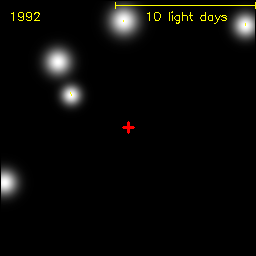
Since 1992 we have observed the central parsec of the galactic center in
K-Band. We mainly use our Speckle-Camera SHARP I on the NTT
located at La Silla, Chile which is operated by the European Southern
Observatory.
Our primary goals are to find out
- whether there is a massive black hole
- when and where the stars were born
- the nature of these stars
- the dynamics in this region
So far, we have shown that at least two periods of star formation have
occured. There are three sorts of stars in the galactic center:
- Stars with He I - emission
- Stars which show CO - absorption
- Embedded stars with featureless spectra
WARNING
- The movie to the right is quite big (roughly
6MB). If you wish, you can stop the download and
download a lightweight MPEG-version.
The orbit of S2
In  Nature's 17 Oct 2002 issue (get article)
we report on having observed 2/3 of a complete orbit of the star currently
closest to the enigmatic radio source Sagittarius A*, which is thought to mark
the location of our Milky Way's massive central black hole. As explained below,
this orbit provides overwhelming evidence that SgrA* is indeed a supermassive
black hole of more than 2 million solar masses. Figures 1,2, and 4 on this page
are taken from the article in Nature. See the star S2 swing around the black
hole in this movie.
Nature's 17 Oct 2002 issue (get article)
we report on having observed 2/3 of a complete orbit of the star currently
closest to the enigmatic radio source Sagittarius A*, which is thought to mark
the location of our Milky Way's massive central black hole. As explained below,
this orbit provides overwhelming evidence that SgrA* is indeed a supermassive
black hole of more than 2 million solar masses. Figures 1,2, and 4 on this page
are taken from the article in Nature. See the star S2 swing around the black
hole in this movie.
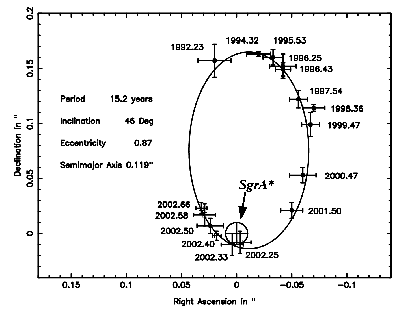
Observations by our
group and by the  UCLA group of the
velocities and accelerations of stars in the Galactic Center over the course of
the last decade have already provided strong evidence that SgrA* is in fact a
black hole of about 2.6 million solar masses. However, these measurements could
not rule out some alternatives to the black hole model. Two such alternatives
are a ball of massive, degenerate fermions, like neutrinos, or a cluster of dark
astrophysical objects, such as stellar mass black holes or neutron stars.
These two alternative explanations can now be excluded by analyzing the orbit
of S2:
UCLA group of the
velocities and accelerations of stars in the Galactic Center over the course of
the last decade have already provided strong evidence that SgrA* is in fact a
black hole of about 2.6 million solar masses. However, these measurements could
not rule out some alternatives to the black hole model. Two such alternatives
are a ball of massive, degenerate fermions, like neutrinos, or a cluster of dark
astrophysical objects, such as stellar mass black holes or neutron stars.
These two alternative explanations can now be excluded by analyzing the orbit
of S2:
In spring 2002 S2 was passing with the extraordinary velocity of more than
5000 km/s at a mere 17 light hours distance -- about three times the size of our
solar system -- through the perinigricon, the point of closest approach
to the black hole. By combining all measurements of the position of S2 made
between spring 1992 and summer 2002, we have obtained enough data in order to
determine a unique keplerian orbit for this star, presented in Figure 1. It is
highly elliptical (eccentricity 0.87), has a semimajor axis of 5.5 light days, a
period of 15.2 years and an inclination of 46 degrees with respect to the plane
of the sky. From Kepler's 3rd law we can determine the enclosed mass in a
straightforward manner to be 3.7±1.5 million solar masses. Therefore at least
2.2 million solar masses have to be enclosed in a region with a radius of 17
light hours. It is not possible to explain this result with a neutrino ball
model because the required neutrino masses would be too large, or with a dense
cluster of dark astrophysical objects because such a cluster would have the
extremely short lifetime of at most a few hundred thousand years. Compared to
the lifetime of our Galaxy of the order of 10 billion years this configuration
is highly improbable. The only remaining alternative to the black hole model is
a ball of bosons, which would be hard to distinguish from a black hole because
of its small size. However, eventually, after some time such a ball would
eventually collapse to a black hole after having accreted enough matter from its
surroundings. Hence, the observed keplerian orbit of S2 around SgrA* provides
compelling evidence for the existence of a massive black hole at the center of
our Galaxy.
On the figure below one can see the enclosed mass derived from different
studies of gas dynamics and stellar dynamics at various distances from the
Galacic Center. The point at the shortest distance is the mass measurement added
with the aid of the newly determined orbit. The fascinating feature of this plot
is that the best fit curve for the enclosed mass is flat inside of about 0.2
parsecs. From this we draw the compelling conclusion that a massive black hole
must be present at the center of the Milky Way.. From the best fit model to all
the data we derive a black hole mass of 2.6±0.2 million solar masses. The long
dash-short dash curve is the power-law model for just the stellar cluster
without the black hole. The dashed curve is for a hypothetical cluster of dark
astrophysical objects, such as neutron stars or black holes, with a power-law
exponent of 5 (Plummer model). Such a cluster would have a mass density higher
than 1x1017Mopc-3. It's lifetime would be
shorter than about 100,000 years.
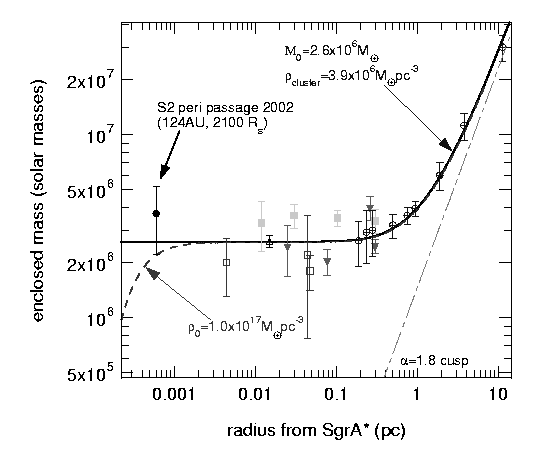
Why
is this finding important to astronomers?
Over the last decades, it has become a standard paradigm that massive black
holes are located at the centers of most, if not all, galaxies. They are
believed to be the central engines powering the enormous energy ouput and
luminosity of active galactic nuclei and of quasars, the most distant and most
luminous objects observed in our universe. Observations of other galactic nuclei
have already provided strong evidence that these massive black holes exist.
However, this evidence has always been indirect and did not exclude alternative
explanations (such as the neutrino ball model). By showing in a direct and
straightforward way that such a massive black hole does indeed exist in the
heart of our own galaxy, the Milky Way, we provide a firm and compelling
fundament for this key hypothesis of modern astronomy.
How
were these observations done?
From 1992 to 2002 we have been observing the center of our Milky Way with the
near-infrared speckle imaging camera SHARP (developed at
MPE) at the European Southern Observatory's  (ESO) NTT telescope in
La Silla Chile. Speckle imaging is a special technique in order to compensate
the atmospheric turbulence and to obtain sharp images at the theoretical
diffraction limit of a telescope despite of the degrading influence of the
Earth's atmosphere. Speckle imaging
involves taking hundreds or thousands of short exposure images of an
astronomical object and the later reconstruction of a sharp image with the aid
of a computer.
(ESO) NTT telescope in
La Silla Chile. Speckle imaging is a special technique in order to compensate
the atmospheric turbulence and to obtain sharp images at the theoretical
diffraction limit of a telescope despite of the degrading influence of the
Earth's atmosphere. Speckle imaging
involves taking hundreds or thousands of short exposure images of an
astronomical object and the later reconstruction of a sharp image with the aid
of a computer.
Another way of compensating atmospheric turbulence is the technique of
adaptive optics. It is more costly and elaborate than speckle imaging, but
provides usually significantly better results. At the end of 2001/beginning of
2002 the near-infrared adpative optics system/infrared camera  NAOS/CONICA was installed on one of ESO's
four 8.2 m VLT telescopes. The combination of these two new powerful instruments
porovided us with the deepest images that were taken of the Galactic Center with
an 8m-class telescope up to date (see image).
NAOS/CONICA was installed on one of ESO's
four 8.2 m VLT telescopes. The combination of these two new powerful instruments
porovided us with the deepest images that were taken of the Galactic Center with
an 8m-class telescope up to date (see image).
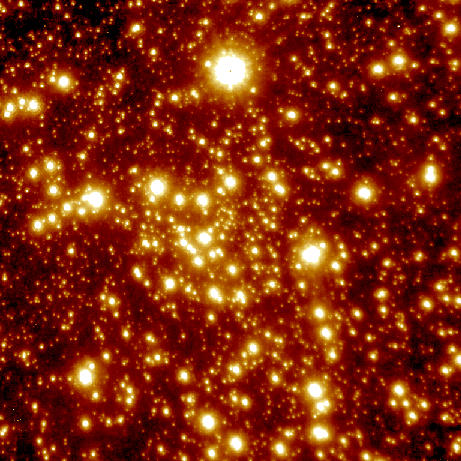
How do we
know where the black hole is?
We cannot see the massive black hole at the center of our Milky Way on our
infrared images. However, in order to examine the dynamics of the stars in its
environment it is essential to know its location on our infrared images with a
very high precision. There exists a certain kind of stars that give off strong
radiation in radio wavelengths as well as in the near-infrared light. On the
images of the Galactic Center taken with NAOS/CONICA we can find seven of these
so-called maser stars. These stars are marked by circles in the image
below. With the knowledge of the exact position of the maser stars relative to
the black hole we can determine the pixel scale, orientation and possible
distortions of our infrared image. In this way we obtain the accurate position
for hundreds of stars relative to the black hole for a given time.
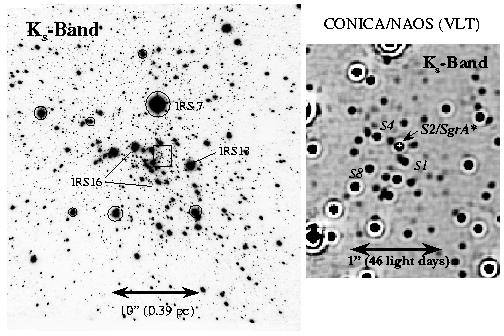
 Nature's 17 Oct 2002 issue (get article)
we report on having observed 2/3 of a complete orbit of the star currently
closest to the enigmatic radio source Sagittarius A*, which is thought to mark
the location of our Milky Way's massive central black hole. As explained below,
this orbit provides overwhelming evidence that SgrA* is indeed a supermassive
black hole of more than 2 million solar masses. Figures 1,2, and 4 on this page
are taken from the article in Nature. See the star S2 swing around the black
hole in this movie.
Nature's 17 Oct 2002 issue (get article)
we report on having observed 2/3 of a complete orbit of the star currently
closest to the enigmatic radio source Sagittarius A*, which is thought to mark
the location of our Milky Way's massive central black hole. As explained below,
this orbit provides overwhelming evidence that SgrA* is indeed a supermassive
black hole of more than 2 million solar masses. Figures 1,2, and 4 on this page
are taken from the article in Nature. See the star S2 swing around the black
hole in this movie. 



